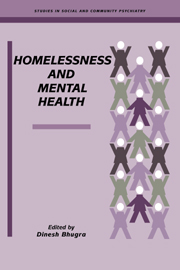Book contents
- Frontmatter
- Contents
- List of contributors
- Preface
- Part I INTRODCTION AND SPECIAL GROUPS
- 1 Introduction
- 2 Homelessness and mental illness: a brief history
- 3 Models of homelessness
- 4 Young homeless and homeless families: a review
- 5 Homeless women
- 6 Homelessness and criminality
- Part II SERVICES
- Part III INTERNATIONAL PERSPECTIVE
- Part IV POLICY AND EVALUATION
- Index
2 - Homelessness and mental illness: a brief history
from Part I - INTRODCTION AND SPECIAL GROUPS
Published online by Cambridge University Press: 15 October 2009
- Frontmatter
- Contents
- List of contributors
- Preface
- Part I INTRODCTION AND SPECIAL GROUPS
- 1 Introduction
- 2 Homelessness and mental illness: a brief history
- 3 Models of homelessness
- 4 Young homeless and homeless families: a review
- 5 Homeless women
- 6 Homelessness and criminality
- Part II SERVICES
- Part III INTERNATIONAL PERSPECTIVE
- Part IV POLICY AND EVALUATION
- Index
Summary
The issue of psychiatric disorder and homelessness is widely believed to be a contemporary phenomenon without historical precedent. Discussion characteristically revolves around the twin topics of hospital closure and ‘care in the community’ policies. However, there are historical antecedents to the contemporary situation, albeit poorly documented. To limit discussion to the provision or nonprovision of psychiatric services is to divorce in an arbitrary and artificial way the history of the homeless mentally ill from the wider context of poverty and homelessness in the UK.
However, the homeless of past centuries were, in the main, without a voice and so all that is left to use are details of legislation, court proceedings, crude occupancy statistics and contemporary mythologies of vagrancy, with the mentally ill mentioned usually only in passing. There have, however, been two common threads running through the centuries. One has been the visibility of the street homeless, leading to the construction of strange mythologies about Mafia-like underworld societies of vagrants (Beier, 1987, pp. 123– 45). The other has been the institution established by the state to deal with the poor and indigent - the workhouse.
The evolution of the workhouse
Both homelessness and society's responses to it are products of social conditions. They have been part of the make-up of British society since the late thirteenth century. The first statutes concerned with the issue of homeless people, or vagrants, were passed in 1349, 1351 and 1388.
Of course, during this period, there still flourished large numbers of monasteries and houses of religion that provided a widespread system of relief to the poor.
- Type
- Chapter
- Information
- Homelessness and Mental Health , pp. 11 - 25Publisher: Cambridge University PressPrint publication year: 1996
- 5
- Cited by



